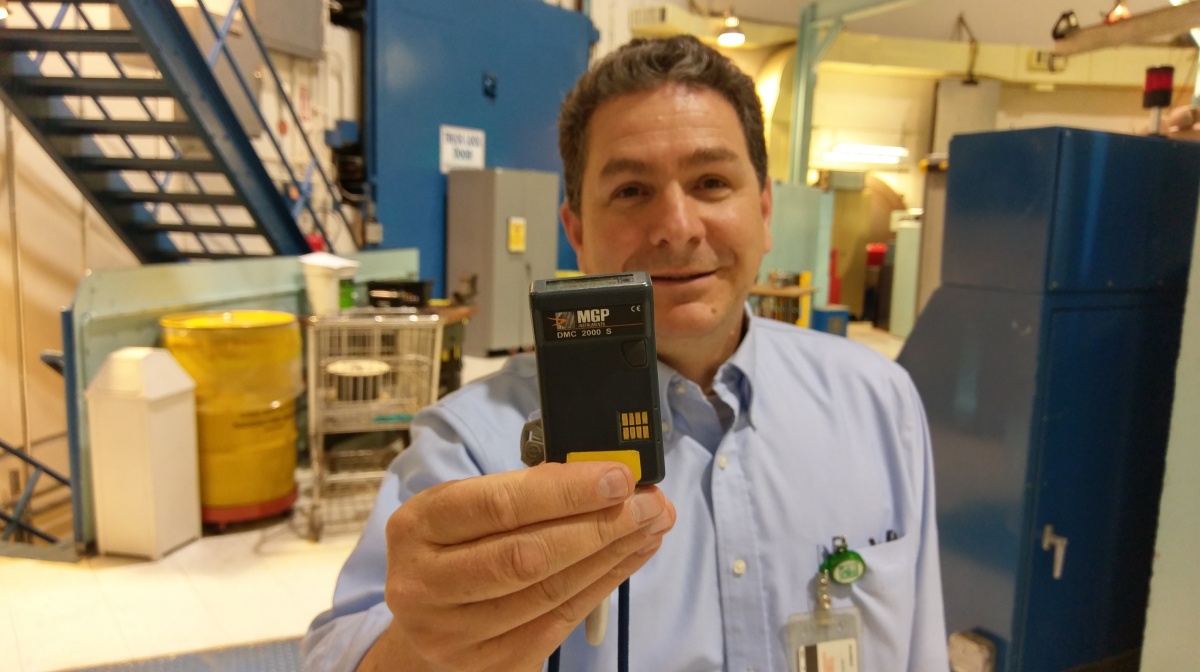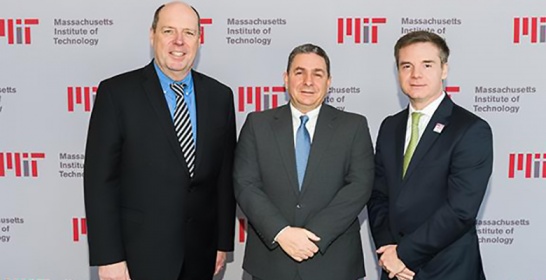Bill McCarthy Recipient of 2017 MIT Excellence Award for Innovative Solutions
From left to right: Martin Schmidt, MIT Provost; Bill McCarthy, Deputy Director of EHS and Reactor Radiation Protection Officer; Israel Ruiz, MIT Executive Vice President and Treasurer.
The 2017 MIT Excellence Awards + Collier Medal ceremony was held on March 16th, acknowledging the extraordinary efforts made by members of the MIT community. Among this year’s award recipients was William (Bill) McCarthy, a Deputy Director of MIT’s Environment, Health and Safety Office and Reactor Radiation Protection Officer at the Nuclear Reactor Laboratory (NRL), who was presented with the Excellence Award for Innovative Solutions.
Bill earned his PhD in Physics and Master of Science in Radiological Sciences from UMass Lowell and is certified by the American Board of Health Physics, as well being a member of their examination panel. He has been at MIT since 1997, conducting radiation safety trainings and assisting lab personnel in the design of safe experiments using radiation sources. Prior to 1997, Bill worked for the Nuclear Regulatory Commission (NRC) Headquarters in the Medical and Academic Section. Since joining the NRL in 2009, overseeing the radiation protection program at the facility, he has introduced significant reductions in staff radiation exposure and built a culture of safety everyone at the NRL has enthusiastically embraced.
To reduce exposure levels, Bill used a winning combination of electronic dosimetry technology and increased communication with NRL staff to produce a more effective ALARA program at the Lab. ALARA, which stands for “as low as reasonably achievable,” is a required program at all NRC licensed facilities to reduce exposures to workers and the general public to reasonable levels. Although radiation exposures were already at acceptable levels prior to Bill’s arrival in 2009, new opportunities were found to further reduce exposure with the help of NRL staff and management. Funds were provided to help purchase items such as shielding and long-handled tools to aid in dose reduction efforts. The Lab has now brought radiation exposure to workers and the public down to more than half of the levels prior to 2009.
The electronic dosimeter program, which allows workers to see their exposures and alarm at determined set points for each individual given the scope of their work, began prior to Bill’s arrival but was still in its early stages. Through optimizing the system, training every worker who was issued an electronic dosimeter on its use, and making exposure levels known to the workers, the usefulness of the electronic dosimeters received a substantial boost.

Bill holding an electronic dosimeter.
The electronic dosimeter program allows dose reports to be generated whenever needed. Valuable insight is gained by displaying everyone’s exposures, but using that information in a proactive way is paramount in keeping exposure levels low. “How you use information and how you share the information among the people who are getting those exposures – that makes a big difference,” explains Bill. “If you don’t do anything, nobody’s going to do anything to reduce their exposures.”
Bill monitors exposure levels and talks with anyone whose dose is unusual compared to what they were scheduled to do that day. Talking with people and thinking about whether or not their doses make sense further helps reduce exposure levels. When people are mindful and aware of their exposure, they happily work to keep those levels low, planning out their work and the radiation exposure that comes with it.
Planning is a central part of ALARA and is also an important tool Bill used in crafting and maintaining a strong safety culture at the NRL. He makes sure that fluid communication exists between NRL operations and radiation protection whenever work is being scheduled at the facility, with exposure levels being taken into consideration for each job. Certain jobs where a little more exposure will be present may need to be scheduled at specific times, while other tasks can be rearranged on the schedule with the intent to lower everyone’s exposures. Without planning a job, both the workers and the job are put at risk. By taking the time to plan scheduled work, workers are safer, they receive lower radiation doses, and the job is typically more efficient when safety gets factored in.

Bill setting up proper signage for a high radiation area.
As one of his colleagues said, “Bill’s efforts have drawn the attention of federal regulators, who see his work as an example of how such a safety program should be run. Bill McCarthy is the future of university safety.” Bill contends, however, that “everybody has to be on board” in order for a safety program to be as strong as the one at the NRL. He admires the cooperation of NRL staff, including the director of the lab, David Moncton, for helping make the safety culture a success. “David Moncton takes safety seriously. He will not only preach it, but he will push it to make sure it happens,” says Bill. Most important to the success of the program was cooperation between workers, management, and the radiation protection staff. Having those who identify sources and the people who can help reduce exposure work together is key to a strong safety program. This, Bill points out, is much easier when you have workers who are interested in keeping their radiation exposures low, as is the case at the NRL.
We appreciate Bill’s enthusiasm for sensible safety and congratulate him on his accomplishment in receiving the MIT Excellence Award for Innovative Solutions.
Click here to learn more about the MIT Excellence Awards, as well as read about previous winners.

